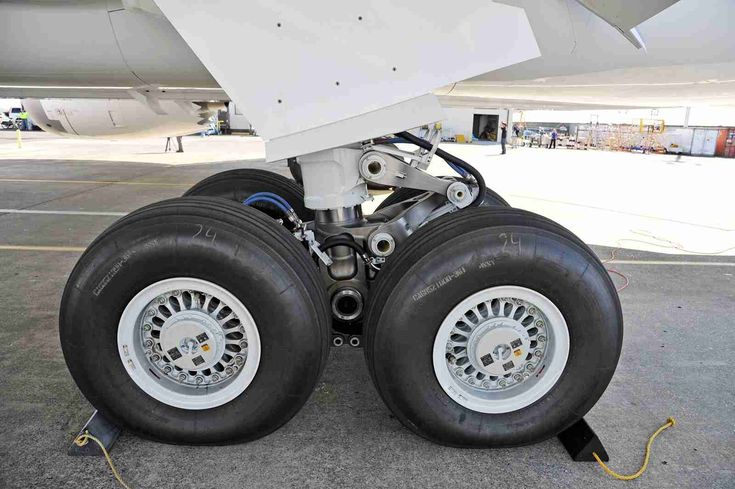Airplanes may be huge, but have you ever noticed how small their tires look in comparison?
If you’ve ever looked out an airport’s window as a plane lands or when it has landed, you may have been surprised at just how small the tires are compared to the plane.
The reason airplane tires are small is because they need to be small to be effective.
Smaller tires are better designed for landing and taking off because they can easily withstand the high temperatures and pressures involved during landing.
Smaller tires also reduce an aircraft’s weight.
Airplane tires are small relative to the size of aircraft, though generally the bigger theaircraft is, the bigger its tires will be.
A majority of commercial plane’s tires are only 27 inches in diameter.
Smaller aircraft have smaller tires at 15 inches in diameter.
The first types of airplane tires were titled the ‘Type 1’, and they had diameters of 27 inches.
Modern general airplane tires are known as the ‘Type 3’ and include more diverse sizes like the 5.00-5 and 6.00-6.
These numbers refer to the tire’s width and the diameter of the rim ledge. So a 5.00-5 has a width of 5 inches and is used for a wheel with 5 inches in diameter.
The King Air uses 8.50-10 size tires. This means that this plane’s tires have a 26 inch diameter when measured from the outside.
The Cessna Hawk XP uses 6.00-6 with 4 PLY tires. These tires have a diameter of 17.5 inches when measured from the outside.
The Boeing 747 uses h59x19.0–20 tires. These tires have a 49-inch diameter when measured from the outside.
The Airbus A320 uses 30×8.8R15 tires. These tires have a diameter of 29.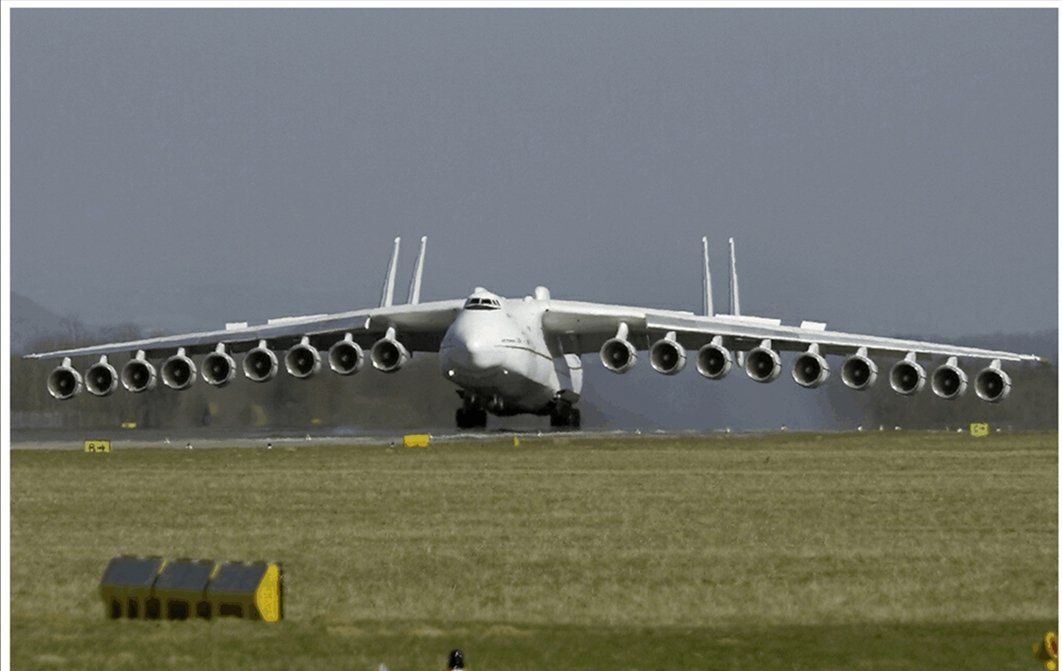 5 inches when measured from the outside.
5 inches when measured from the outside.
The F-15 uses 34.5×9.75–18 tires. This means the F-15’s tires have a diameter of 34.5 inches when measured from outside.
The C-130 uses tires of a 56×20/24PR size. This means the C-130 tires have a diameter of 55.5 inches when measured from outside.
An airplane tire’s footprint, which is the amount of surface area of the tire that touches the ground, times air pressure, must match an aircraft’s weight to support an aircraft.
Since air pressure is generally large, airplane tires need to be small.
Large tires would not benefit aircraft. Instead, having larger tires would result in airplanes not being able to land properly.
Larger tires increase an aircraft’s load and could damage runways. Additionally, larger tires would make a plane bounce more when landing.
In view of these considerations, it makes sense to keep airplane tires as small as possible.
The Airbus A380 has the largest commercial plane tire size in the world at 56 inches in diameter and 21 inches in width.
The A380 uses 22 tires.
The largest aircraft tires ever made were for the B-36 Bomber in the 1950s.
These tires were over 5 feet in width and 10 feet in diameter.
The airplane tire manufacturing industry is dominated by 4 firms that control 85% of the global market. These firms are:
The remaining 15% of the global airplane tire market is mostly made up by small manufacturers in other countries like China.
Some of these other companies include Guilin lanyu Aircraft tire Development Co, which is a subsidiary of ChemChina.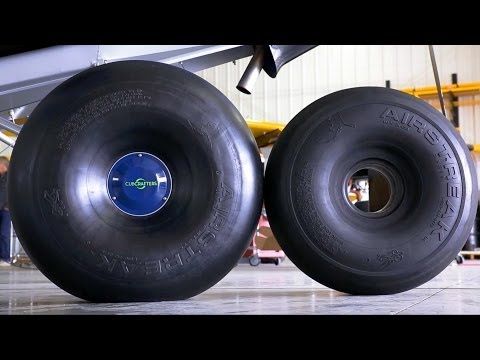
Many helicopters and planes have the same tire size. This is especially true for general aviation aircraft.
Helicopter tires are also designed similarly to airplane tires since helicopter tires face the same pressures and temperatures as airplane tires.
But, trucks have larger tires than both helicopters and airplanes.
Truck tire sizes vary widely, but the average truck will have a larger tire than the average airplane or helicopter.
Related: Do Helicopters Have Wheels?
The average airplane tires can withstand 500 landings before requiring repair.
Typically, after 500 landings, the tire’s top layer is peeled off and needs to be replaced with new treading.
Unless the rest of the tire also suffers damage, normally just the tread will be replaced.
Related: How Long Do Airplane Tires Last?
Airplane tires are made of proprietary rubber compounds, aluminum steel reinforcements and nylon and aramid fabrics.
These materials ensure that the tire has sufficient strength to support a plane.
Airplane tires are also inflated with nitrogen to prevent explosions during impact.
Nitrogen is an inert gas, so the high pressure and temperature changes during landing don’t affect it as much as they do regular air-filled tires.
Depending on numerous factors, a plane’s tires could be changed anywhere between 120 to 400 landings.
Airplane tires need to withstand both extreme temperatures and high pressures.
Long-range airplanes like the Boeing 747 also complete thousands of takeoffs and landing over their course of operations, so most aircraft will frequently need their tires changed.
Longer-range aircraft tend to have more tires changed over the course of their operation than shorter range aircraft.
In conclusion, airplane tires are relatively small compared to the planes they’re fitted on. Airplane tires are small because they need to be.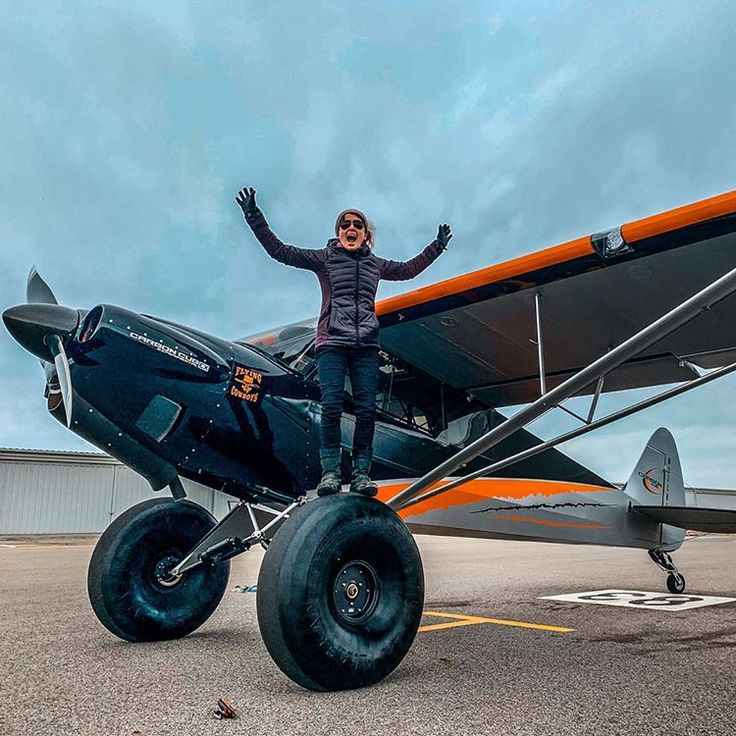 Smaller tires have reduced surface area contact with the ground and reduce aircraft’s weight.
Smaller tires have reduced surface area contact with the ground and reduce aircraft’s weight.
See Also: How Many Wheels Do Airplanes Have?
You see the shredded remnants of car tires littering the highway all the time, yet you've almost certainly never witnessed or even read about a tire blowout on an airliner. Why not? Aircraft that weigh as much as buildings come in at 170 mph on airliner tires, made of basically the same materials as car tires, thousands of times every day. You'd think every now and then there would be a blowout.
But there almost never is. The simple reason is that airliner tires are blown up to about 200 psi, or about six times the psi of a car tire, according to Wired. It is the high air pressure that gives airliner tires their strength. Of course, the tire construction needs to be tougher stuff than your average car tire, but the strength of the rubber compounds is primarily to allow such high pressure inflations rather than to resist impact on landing.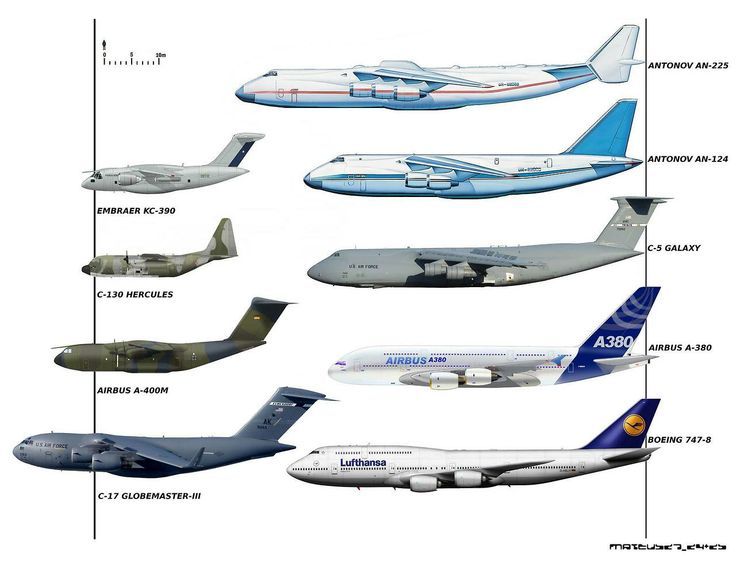
Michelin
Airliner tires aren't particularly large—the Boeing 737 tires measure 27x7.75 R15, which means they are 27 inches in diameter, 7.75 inches wide, and they are placed on a 15-inch rim. This is much smaller than a semi-truck tire, which can be over 40 inches in diameter and almost 20 inches wide. But plane tires are incredibly strong thanks to cords of nylon, or a synthetic polymer called aramid, that are embedded below the tread.
Aviation regulations require that airliner tires be able to withstand four times their rated pressure for at least three seconds, and the toughest tires can stand up to a landing at 288 mph. "It is almost impossible to blow out a tire by over inflating it," Lee Bartholomew, lead test engineer for Michelin Aircraft Tires, told Wired. "In fact, in cases where tires have been over-inflated, the wheel actually fails before the tire."
The simple tread pattern, designed primarily to prevent hydroplaning, and the reinforcing cords embedded beneath allow commercial airplane tires to touch down at high speeds and drag along the tarmac, which is why you see smoke, before the rotation of the wheels catches up to the velocity of the plane.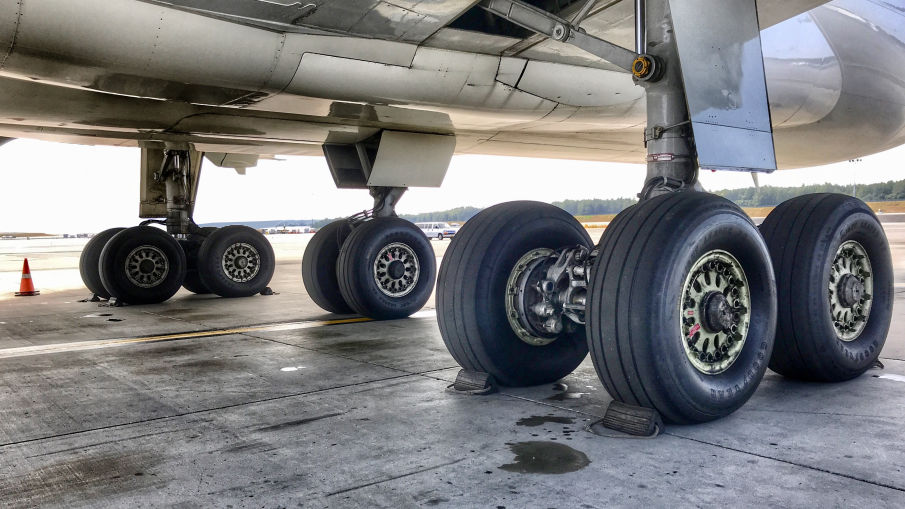 Most of the wear and tear to an airplane's tires comes during this initial touchdown while the tires are skidding along rather than rolling. But even so, commercial airplane tires can touch down about 500 times before they need to be re-tread, and a tire can be restored this way up to seven times over the course of its life.
Most of the wear and tear to an airplane's tires comes during this initial touchdown while the tires are skidding along rather than rolling. But even so, commercial airplane tires can touch down about 500 times before they need to be re-tread, and a tire can be restored this way up to seven times over the course of its life.
Of course, blowouts on airplanes do happen occasionally, usually due to under-inflation. But large commerical or cargo aircraft, such as the Airbus A380, often have more than 20 tires, providing enough stability to safely land even if one fails.
Thanks to over-engineering, tires are just one more reason commercial flights are much safer than driving down the highway.
Source: Wired
Jay Bennett
Associate Editor
Jay Bennett is the associate editor of PopularMechanics.com. He has also written for Smithsonian, Popular Science and Outside Magazine.

The modern aircraft tire is a complex, high-tech structure designed to handle enormous speeds and loads at the highest possible weight and size. Despite this, the tire is one of the least understood and most underestimated elements of an aircraft. Everyone will agree that they are "dirty, black and round." But in reality, an aircraft tire is a multi-element component constructed from three materials: cord, rubber, and metal. By weight, an aircraft tire is 50% rubber, 45% cord and 5% metal. Digging into the component materials in more detail, you can see the different types of rubber compounds and nylon cords. They have their own special properties for the successful completion of tasks. nine0003
All aircraft tires can be divided into 2 categories:
Before mounting a tire on an aircraft wheel, a series of tests are carried out over it.
These test checks are divided into static and dynamic.
Static
1. Strength test under internal hydraulic pressure. Method: a tire is mounted on a test wheel and pumped with water to the point of rupture. For a certain time, the tire must withstand the load without destruction. nine0003
2. Determining the tire pressure on the wheel rim. One of the methods is copying. Place one copy sheet between two sheets of plain paper. Then this paper "structure" is installed between the wheel flange and the tire bead. Next, the tire is pumped up. When the heel of the wheel bead touches the vertical surface of the flange, the fit pressure on the rim is recorded. This will be reflected in the form of a trace on plain paper from the copy sheet.
3.Identification of the tightness of tubeless aircraft tires. The tire is inflated to the maximum pressure and kept at the same temperature for a certain time. During this time, the pressure inside the tire decreases due to the increase in its dimensions. Next, measure the pressure difference, how much it fell over the allotted time.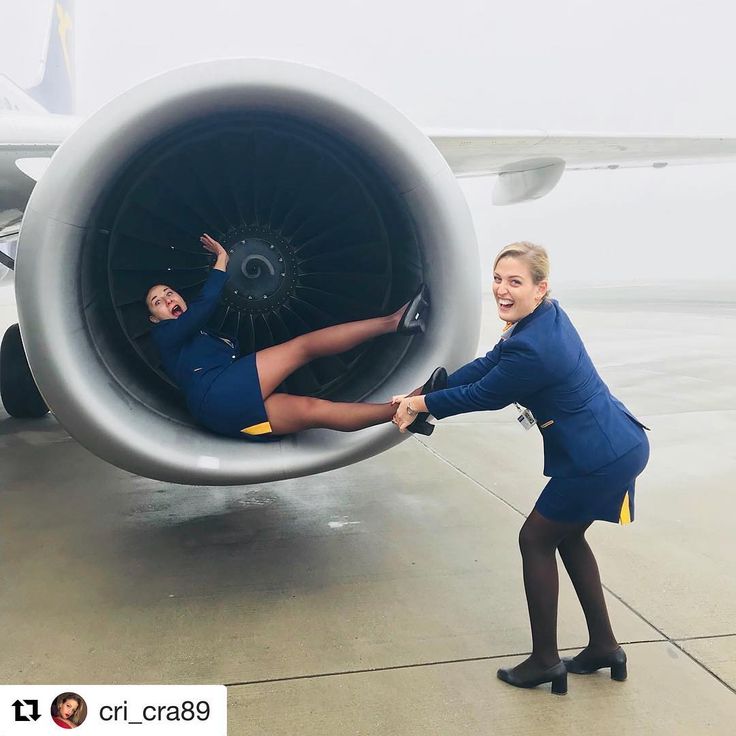 nine0003
nine0003
4. Determination of tire dimensions. The aircraft tire is installed on the wheel, pumped up to the maximum nominal pressure. A certain time is kept at room temperature. After the end of this time, the tire is pumped up to its original value. Then the following values are measured: outer width, outer diameter, width and diameter along the shoulder area.
Dynamic
The influence of the curvature of the drum is taken into account. nine0003
2. Carrying out dynamic tests of tires in conditions as close as possible to operation: for speed, load, etc.
How to change jet tires
Aircraft tires are admired in the air and safe on the ground. But landings and takeoffs have a negative impact on their condition.
During the year, an aircraft travels a distance of 8 thousand kilometers on the ground, taxiing, maneuvering, flying in and landing. Contacts of aircraft landing gear elements with the runway strongly affect tire wear.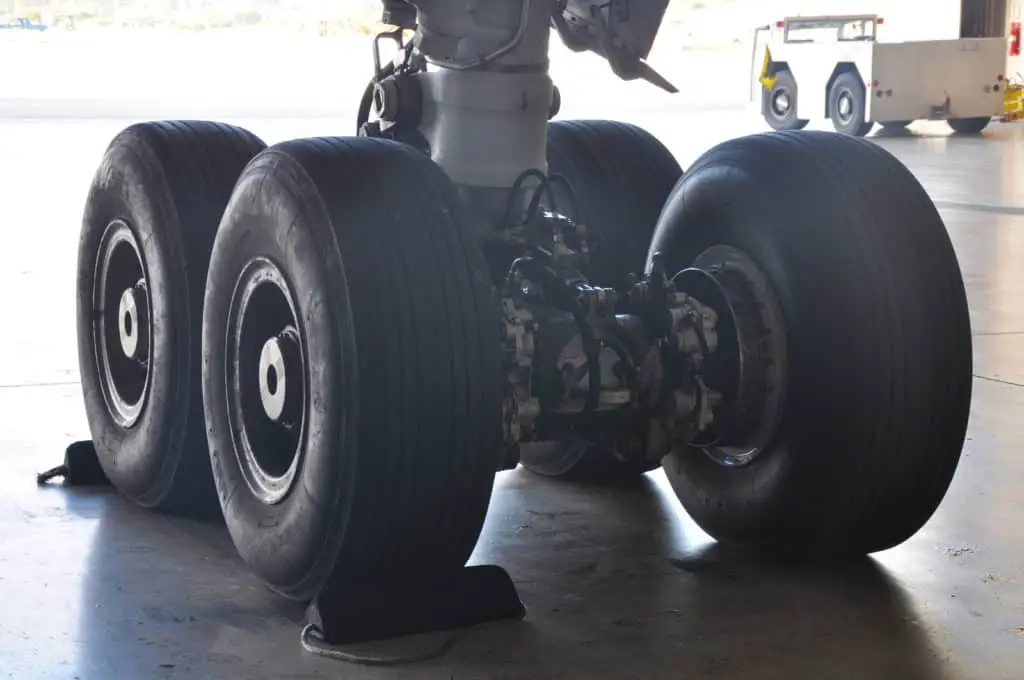 Changing tires is a real problem for airlines because it costs a lot of money, but for air carriers, safety always comes first. A qualified team of tire fitters is required to complete the change within 30 minutes. nine0003
Changing tires is a real problem for airlines because it costs a lot of money, but for air carriers, safety always comes first. A qualified team of tire fitters is required to complete the change within 30 minutes. nine0003
Frankfurt has one of the busiest international airports and is home to one of the largest airlines, Lufthansa.
The aircraft taxis to the parking lot, a team of specialists begins work. The beginning of the process is very similar to replacing car tires, the only difference is that if the car has 4 wheels, then the plane has as many as 30. Blocks of 8 pieces are located under the nose and wings and are attached to the so-called. carts. The trolley is lifted using a jack. The jack's hydraulic pump uses the pressure inside the tire. nine0003
after an emergency landing
Having lifted the structure, the team removes the wheel. First, the specialist unscrews the fixing nut. From the skillfully honed movements of the mechanics, it can be seen that the work is ordinary. The price of a mistake is high and is measured by the lives of people who will fly this plane. Mechanics need to know when it is time to change a tire. Diagnostic markers for this are located in the tread grooves. If these indicators are not visible, then the tire needs to be changed.
The price of a mistake is high and is measured by the lives of people who will fly this plane. Mechanics need to know when it is time to change a tire. Diagnostic markers for this are located in the tread grooves. If these indicators are not visible, then the tire needs to be changed.
When you remove a tire, you can see its huge dimensions: width - 0.5 m, diameter - 1.5 m.
Aircraft tires are under enormous stress. For several hours they are in conditions of very low temperatures, and during the landing of the aircraft they pick up speed up to 280 km / h. When landing, the tire temperature is 260°C. Why, then, do these components not explode in the air and burst on contact with the runway pavement?
The secret is inside the tire: it is not filled with compressed air, like a tire, but with nitrogen gas. Therefore, aircraft tires are always dry, without water inside and cannot freeze. They are also non-flammable. nine0003
It took the German mechanics 15 minutes to make one wheel, and they proceed to remove the next wheel, and put the “changed shoes” in place.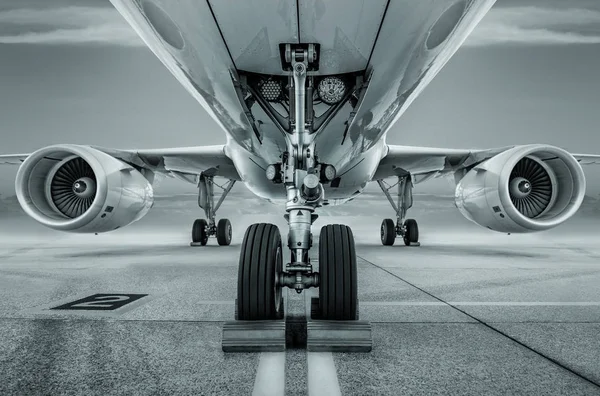 The specialist carefully checks the tightening of the bolts, because their loosening threatens with disaster.
The specialist carefully checks the tightening of the bolts, because their loosening threatens with disaster.
Next, the tires are inflated, the jack is lowered, they are checked to see if all the bolts are in place, and they are strengthened with safety wire. This completes the tire replacement process.
Source: Journal "Science and Technique"
| Author: | Nikolai Makarenko |
Modern Aviation Structure - a complex high -tech structure and one of the most least understood and most underestimated aircraft elements. An aircraft tire is a multi-element component constructed from three materials: cord, rubber, and metal. By weight, an aircraft tire is 50% rubber, 45% cord and 5% metal.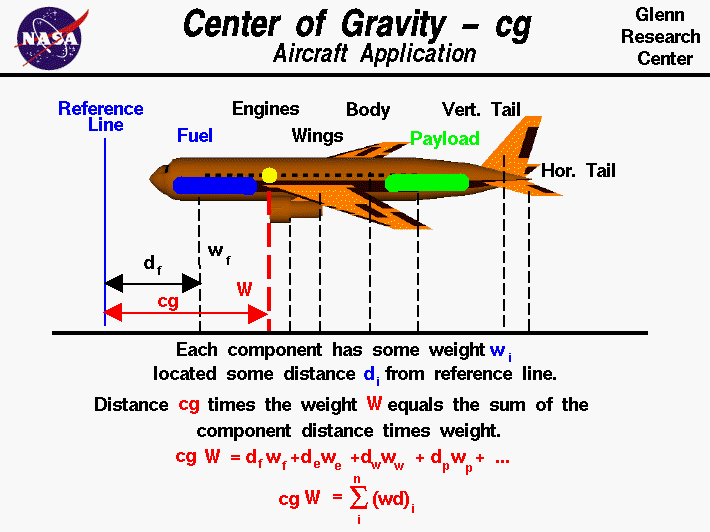 nine0003
nine0003
When landing an aircraft, the landing gear experiences not only colossal static, but also dynamic loads perceived by the struts and wheels. Add to this that during the flight the wheels were motionless, and when touching the runway, they should quickly gain momentum corresponding to the landing speed. Thus, rather high and strict requirements are imposed on the chassis of modern aircraft.
Aircraft tire and wheel assemblies can operate under high pressure to carry the load placed on them and should be treated with the same care as any other pressure vessel. Multiple carcass plies are bonded together to form a common carcass, making the tire capable of holding internal pressure. nine0003
By significantly reducing the weight of tires and at the same time increasing the number of landings they can withstand, operating and fuel costs are reduced. The result is a reduction in the negative impact on the environment by reducing CO2 emissions into the atmosphere and using less raw materials.
Suspension struts
The most heavily loaded elements of the aircraft chassis are shock struts and wheels (pneumatics). nine0003
Suspension struts are used to ensure maximum ride smoothness when driving along the airfield, on the takeoff run and run, as well as to dampen shocks that occur at the time of landing (multi-chamber nitrogen-oil long-stroke shock absorbers are often used, in which the function of a spring element is performed by pumped under a strictly defined pressure technical nitrogen). On the multi-wheeled bogies of the landing gear of heavy aircraft, additional shock absorbers can also be installed - stabilizing dampers. Reinforced landing gear is able to withstand impact on the protruding edges of concrete slabs up to 10 cm high when the aircraft is moving at landing speed or a rough landing. nine0003
There is also a system of braces, rods and hinges that perceive the reactions of the supporting surface and fasten the suspension struts and wheels to the wing and fuselage, which simultaneously serve as a retraction-release mechanism.
Aircraft landing gear wheels support the aircraft on the ground and provide the means of mobility for takeoff, landing and taxiing. And pneumatic tires, shock-absorbing, protect the aircraft from shock impulses due to surface irregularities and shortcomings in piloting technique during landing. nine0003
Wheel discs (drums) are often made of magnesium-based alloys. Usually these are magnesium-zinc alloys, which are very difficult to process, or titanium. Currently, only a few industrial powers in the world can produce high performance fighter aircraft tires.
Complex high-tech structure
Aircraft wheels are designed to make changing tires (tires) easy. The wheel disks themselves are usually made collapsible, from two halves, which are bolted together. To increase the tightness of the wheels, before assembly, both halves of the disk and the outer sides of the tire are treated with a special adhesive, and only after that they are assembled. nine0003
On modern high-speed aircraft, pneumatics are tubeless and are inflated with technical nitrogen (the latter is used to prevent gas condensation and its subsequent freezing at altitude, with the formation of dangerous ice, and besides, nitrogen is cheap and does not burn).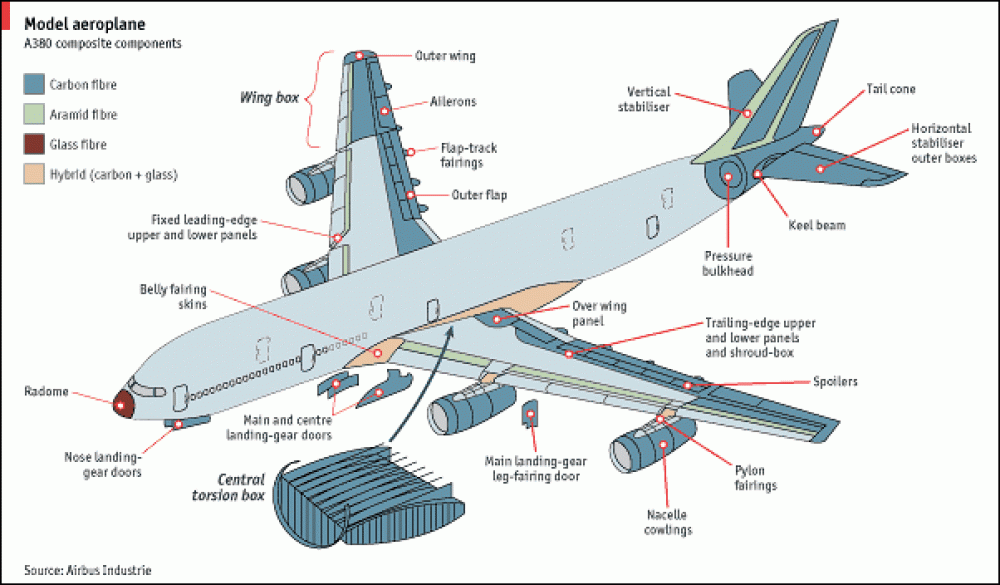 Aircraft landing gear tire treads have no pattern other than a few longitudinal circumferential bleed grooves to reduce hydroplaning effects, as well as control dimples for easy wear detection. The shape of the tire is close to round in cross-section to ensure maximum wheel contact patch during roll landings. Pneumatics are equipped with disc or shoe brakes with hydraulic, pneumatic or electric drive, for maneuvering when moving along the airfield and reducing the length of the run after landing. nine0003
Aircraft landing gear tire treads have no pattern other than a few longitudinal circumferential bleed grooves to reduce hydroplaning effects, as well as control dimples for easy wear detection. The shape of the tire is close to round in cross-section to ensure maximum wheel contact patch during roll landings. Pneumatics are equipped with disc or shoe brakes with hydraulic, pneumatic or electric drive, for maneuvering when moving along the airfield and reducing the length of the run after landing. nine0003
In general, a modern aircraft tire is a complex high-tech structure that operates at high speeds and loads with the smallest possible weight and size.
Aircraft tire capable of withstanding a wide range of operating conditions. While on the ground, it must support the mass of the aircraft. During taxiing, provide a stable, smooth ride while resisting heat build-up, abrasion and wear. During takeoff, the tire structure must be able to withstand not only the aircraft load, but also the forces generated at high roll speeds during the takeoff run. Landing requires the tire to absorb colossal dynamic shock loads. All these processes must be carried out stably, ensuring a long and reliable tire life. nine0003
Landing requires the tire to absorb colossal dynamic shock loads. All these processes must be carried out stably, ensuring a long and reliable tire life. nine0003
These extreme requirements require a fairly complex tire. A modern aircraft tire is a composite of several different rubber compounds (a mixture of natural and synthetic rubber), textile material and steel. Each tire component serves a specific purpose in realizing its performance characteristics. Aircraft tires are very durable, as they are reinforced with iron cords, nylon, and aramid polymer.
The requirements for aircraft landing gear tires and wheels are generally quite strict and sometimes contradictory
For example:
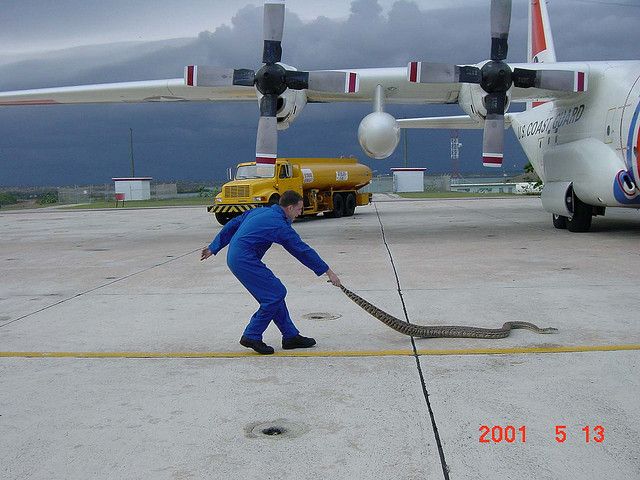
High pressure
It is aircraft wheels that in many ways contain most of the latest inventions put into practice today. By aviation standards, a tire must withstand pressure four times higher than what it is designed for, so theoretically tires can withstand a hard landing at speeds over 450 km / h.
In addition to being subjected to enormous static and dynamic loads, aircraft tires are also subjected to thermal stress when they are exposed to low temperatures for long periods of time, and during landing they quickly pick up speeds of about 300 km/h (some up to 460 km/h). When in contact with the ground, the temperature of the tire rises to 260°C. nine0003
Tires withstand temperature difference and load stably. They are designed to resist wear and tear as much as possible. They are multi-layered with a strong nylon and aramid cord located under each layer. Each layer has the ability to withstand enormous load and air pressure.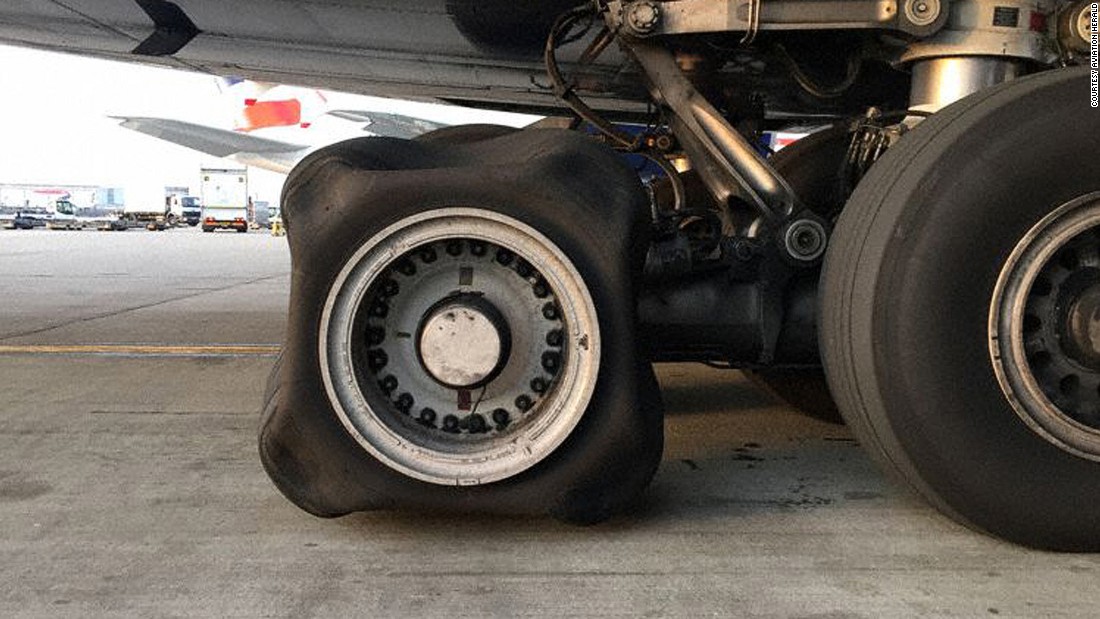 The cord is not intertwined, but arranged in single layers parallel and held together by thin rubber films, which protects the cord from adjacent layers from chafing against each other when the tire is bent during operation. nine0003
The cord is not intertwined, but arranged in single layers parallel and held together by thin rubber films, which protects the cord from adjacent layers from chafing against each other when the tire is bent during operation. nine0003
During tire manufacture, the plies are applied in pairs such that the cords of adjacent plies are at 90° to each other in the case of a crossed (diagonal) tire and from bead to bead at an approximate 90° angle to the centerline of the tire in a radial tire.
To absorb and distribute dynamic loads and protect the body from impact damage, there are two narrow layers pressed into thick rubber layers between the body and the tread. These special layers are called belts. nine0003
Tire strength index
Tire manufacturers assign a ply rating to each tire. This norm does not directly refer to the number of layers in the tire, but is a tire strength index.
Wire wrap is made rigid by rubber banding all of the wire together, creating a strong bond.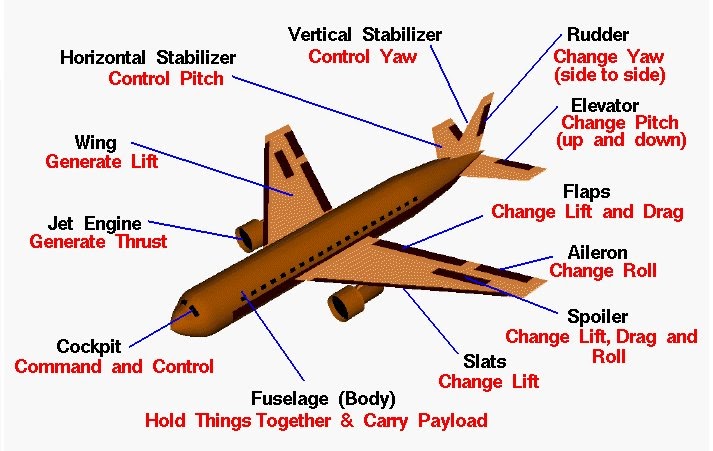 The bead wire (the core of the bead) is also strengthened by winding with fabric strips before the application of the main and filler tapes. The main bands, made of rubber and located under the rubberized fabric filler bands, provide more rigidity and less abrupt changes in the bead section. They also increase the contact area. nine0003
The bead wire (the core of the bead) is also strengthened by winding with fabric strips before the application of the main and filler tapes. The main bands, made of rubber and located under the rubberized fabric filler bands, provide more rigidity and less abrupt changes in the bead section. They also increase the contact area. nine0003
Under severe braking conditions, the heating of the wheel, tire and brake can be sufficient to cause a tire to burst, with possible catastrophic consequences for the aircraft. Thermal witnesses are installed on some tubeless wheels to prevent sudden rupture. These plugs are installed in the wheel drum using a low-melting alloy that melts under overheating conditions and is pushed out by the increased air pressure in the tire. This prevents excessive pressure build-up in the tire by controlled depressurization of the tire. nine0003
Aircraft wheels, like everything related to aviation, are characterized by constant monitoring of their technical condition, so tire pressure is checked every time after landing and before takeoff.
But landings and take-offs have a negative impact on the condition of tires, so aircraft wheels, unlike car wheels, have a relatively short shelf life, and at the slightest suspicion of defects, mechanics must be replaced.
Static and dynamic tests
Static
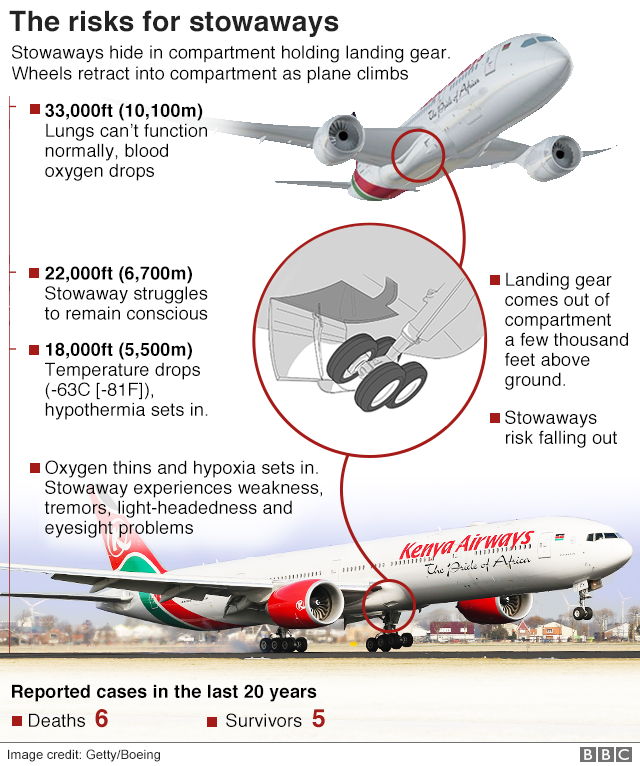 The tire is inflated to the maximum pressure and kept at the same temperature for a certain time. During this time, the pressure inside the tire decreases due to the increase in its dimensions. Next, measure the pressure difference, how much it fell over the allotted time.
The tire is inflated to the maximum pressure and kept at the same temperature for a certain time. During this time, the pressure inside the tire decreases due to the increase in its dimensions. Next, measure the pressure difference, how much it fell over the allotted time. Dynamic
Press Digest for December 6, 2019 | Digest of publications for December 6, 2019
The copyright for this material belongs to the journal Science and Technology.